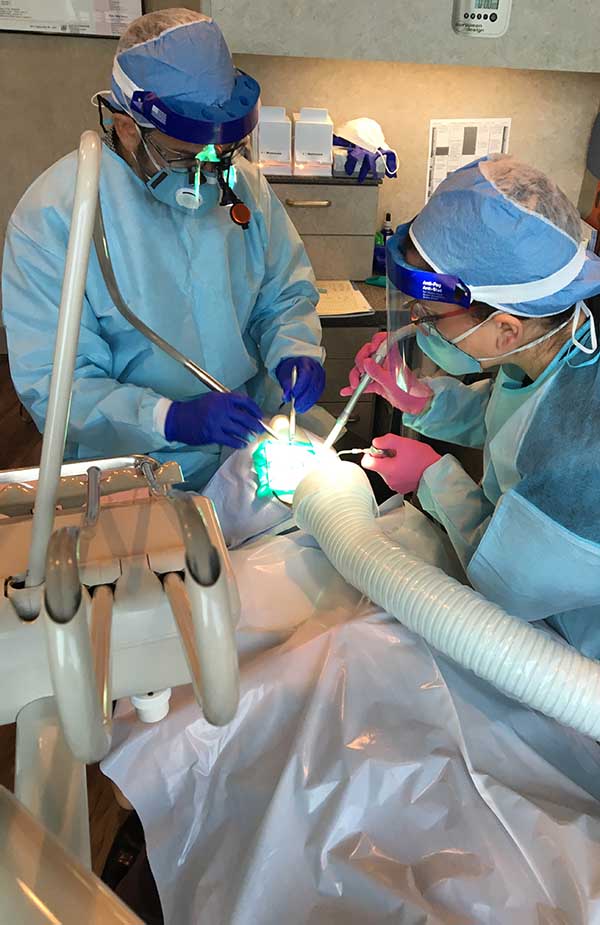The IAOMT protocol recommendations for amalgam removal are known as the Safe Mercury Amalgam Removal Technique (SMART). Note that SMART is presented as a set of recommendations. Licensed practitioners must exercise their own judgment concerning the specific treatment options to utilize in their practices. The SMART protocol recommendations include the following measures, which are listed here with scientific research:

The IAOMT safe amalgam removal protocol recommendations were most recently updated on July 19, 2019. Also, on July 1, 2016, the IAOMT protocol recommendations were officially renamed as the Safe Mercury Amalgam Removal Technique (SMART), and a training course for IAOMT dentists to become certified in SMART was initiated.
All dental amalgam restorations contain approximately 50% mercury,1 and reports and research are consistent that these fillings emit mercury vapors.2-16
Scientific research demonstrates that dental mercury amalgam exposes dental professionals, dental staff, dental patients, and/or fetuses to releases of mercury vapor, mercury-containing particulate, and/or other forms of mercury contamination.4-48
Furthermore, mercury vapor is known to be released from dental mercury amalgam fillings at higher rates during brushing, cleaning, clenching of teeth, chewing, etc.,5, 14, 15, 24, 30, 49-54 and mercury is also known to be released during the placement, replacement, and removal of dental mercury amalgam fillings.2, 25, 28, 29, 32, 36, 41, 45, 46, 55-60
Utilizing the available scientific evidence, the IAOMT has developed extensive safety recommendations for removal of existing dental mercury amalgam fillings, including detailed protective measures that are to be utilized for the procedure. The IAOMT’s recommendations build upon traditional safe amalgam removal techniques such as the use of masks, water irrigation, and high volume suction by supplementing these conventional strategies with a number of additional protective measures, the need for which have only recently been identified in scientific research.
- An amalgam separator must be properly installed, utilized, and maintained to collect mercury amalgam waste so that it is not released into the effluent from the dental office.25, 61-73
- Each room where mercury fillings are removed must have adequate filtration in place,29, 74-76 which requires a high-volume air filtration system (such as an at source oral aerosol vacuum) capable of removing mercury vapor and amalgam particles generated during the removal of one or more mercury fillings.45, 77
- If possible, windows should be opened to reduce the mercury concentration in the air.29, 77-79
- The patient will be given a slurry of charcoal, chlorella, or similar adsorbent to rinse and swallow before the procedure (unless the patient declines or there are other contraindications making this clinically inappropriate).77, 80, 81
- Protective gowns and covers for the dentist,25, 45 dental personnel,25, 45 and the patient45 must be in place. All present in the room must be protected because substantial quantities of particles generated during the procedure will elude collection by suction devices.36, 45 It has been demonstrated that these particles can be spread from the patient’s mouth to the hands, arms, face, chest and other parts of the dental worker’s and patient’s anatomy.45
- Non-latex nitrile gloves must be utilized by the dentist and all dental personnel in the room.45, 46, 77, 82-83
- Face shields and hair/head coverings are to be utilized by the dentist and all dental personnel in the room.45, 77, 80
- Either a properly-sealed, respiratory grade mask rated to capture mercury or a positive pressure, properly-sealed mask providing air or oxygen must be worn by the dentist and all dental personnel in the room.36, 45, 76, 77
- In order to protect the patient’s skin and clothing, a full body, impermeable barrier, as well as a full head/face/neck barrier under/around the dam, need to be utilized.45, 77, 80
- External air or oxygen delivered via a nasal mask for the patient also needs to be utilized to assure the patient does not inhale any mercury vapor or amalgam particulate during the procedure.45, 77, 80 A nasal cannula is an acceptable alternative for this purpose as long as the patient’s nose is completely covered with an impermeable barrier.
- A dental dam74-76, 84-87 that is made with non-latex nitrile material45, 77, 83 must be placed and properly sealed in the patient’s mouth.
- A saliva ejector must be placed under the dental dam to reduce mercury exposure to the patient.45, 77
- During amalgam filling removal, the dentist must utilize an at source oral aerosol vacuum in close proximity to the operating field (i.e., two to four inches from the patient’s mouth) to mitigate mercury exposure.45, 88
- High speed evacuation produces better capture when fitted with a Clean Up device,45, 87 which is not mandatory but is preferred.
- Copious amounts of water to reduce heat45, 74, 76, 77, 86, 89-91 and a conventional high speed evacuation device to capture mercury discharges25, 29, 45, 74-77, 86, 90, 91 are required to reduce ambient mercury levels.46
- The amalgam needs to be sectioned into chunks and removed in as large of pieces as possible,45, 74, 77, 80 using a small diameter carbide drill.29, 86
- Once the removal process is complete, the patient’s mouth should be thoroughly flushed with water77, 80 and then rinsed out with a slurry of charcoal, chlorella or similar adsorbent.81
- Dentists must comply with federal, state, and local regulations addressing the proper handling, cleaning, and/or disposal of mercury-contaminated components, clothing, equipment, surfaces of the room, and flooring in the dental office.
- During the opening and maintenance of suction traps in operatories or on the main suction unit, dental staff should utilize the appropriate personal protection equipment described above.
It is important to note that as a safety precaution, the IAOMT does not recommend amalgam filling removal for women who are pregnant or breast-feeding and that the IAOMT does not recommend that dental personnel who are pregnant or breast-feeding conduct work that disrupts amalgam fillings (including their removal).


